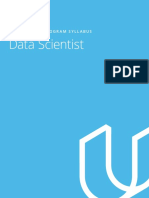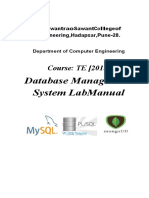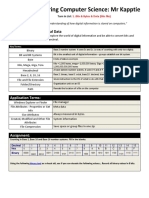Exploringcomputerscience 1
Uploaded by
api-441383155Exploringcomputerscience 1
Uploaded by
api-441383155STRANDS AND STANDARDS
EXPLORING COMPUTER SCIENCE 1
Course Description
Exploring Computer Science 1 is designed to introduce students to the breadth of the field of
computer science through an exploration of engaging and accessible topics. Rather than
focusing the entire course on learning particular software tools or programming languages, the
course is designed to focus the conceptual ideas of computing and help students understand
why certain tools or languages might be utilized to solve particular problems. The goal of
Exploring Computer Science 1 is to develop in students the computational thinking practices
of algorithm development, problem solving and programming within the context of problems
that are relevant to the lives of today's students. Students will also be introduced to topics
such as interface design, limits of computers and societal and ethical issues.
· Learning that works for Utah
ADA Compliant: July 2018
EXPLORING COMPUTER SCIENCE 1
Intended Grade Level 7-9
Units of Credit 0.5
Core Code 35.02.00.00.007
Concurrent Enrollment Core Code N/A
Prerequisite N/A
Skill Certification Test Number 802, 9830
Test Weight 0.5 or 1.0
License Type CTE and/or Secondary Education 6-12
Required Endorsement(s)
Endorsement 1 Exploring CS, or
Endorsement 2 Web Development, or
Endorsement 3 Computer Programming (Historic), or
Endorsement 4 Multimedia, or
Endorsement 5 Computer Science Level 1, or
Endorsement 6 Computer Science Level 2, or
Endorsement 7 Business & Marketing Information Technology
STRAND 1
Human and Computer Interaction (suggested time frame: 6-8 weeks). Students learn the
components and uses of a computer.
Standard 1
Analyze the characteristics of hardware components including processor, operating system,
RAM, ROM, hard drive, and input and output devices. Discuss gigahertz, kilobyte, megabyte,
gigabyte and terabyte.
Standard 2
Determine the software applications for which computers can be used including word
processing, presentation, and spreadsheets and browsers.
• Resource-Exploring Computer Science Curriculum V7 Day 3-4
Standard 3
Use tools to yield requested data for Web searches including search engines and appropriate
keywords.
• Resource- Exploring Computer Science Curriculum V7 Day 5-7
Standard 4
Evaluate the results of web searches and the reliability of information found on the Web
including authority, purpose, coverage, accuracy, objectivity, currency, and accessibility.
• Resource- Exploring Computer Science Curriculum V7 Day 5-7
2|Page July 2018
EXPLORING COMPUTER SCIENCE 1
Standard 5
Computers and tasks they perform
• Identify required functions for a device to be classified as a computer (takes input,
processing; output; storage)
• Identify examples of tasks that can and cannot be accomplished with a computer.
• Resource- Exploring Computer Science Curriculum V7 Day 15-16, 17-19
Standard 6
Describe changes technology has made on communication, privacy and social interactions.
• Appropriate uses of Social Media
• Permanence of online information
• Methods of communication appropriate for different situations
• Online safety
• Resource -Exploring Computer Science Curriculum V7 Day 8-9
Performance Skills
• Compare and contrast options for hardware and operating system software in
computers and devices available today.
• Learn the characteristics that make certain tasks easy or difficult for computers.
• Become “computational thinkers” by applying a variety of problem-solving
techniques.
• Students are able to apply the problem-solving process to a real–world situation.
• Identify ethical behavior including responsibilities of software users and software
developers with respect to privacy and software development.
STRAND 2
Problem Solving (4 weeks). This unit focuses on developing computational practices and
understanding the connections between problem solving, mathematics and computer
science.
Standard 1
Define computational practices (thought processes involved in expressing
solutions to problems that can be carried out by a computer)
• Role of communication and collaboration in problem solving (computational
thinking)
• Designing and implementing creative solutions
• Persevering and troubleshooting-break down the problem
• Resource- Exploring Computer Science Curriculum V7 page 12
Standard 2
Solve a problem by applying appropriate problem solving techniques (1: Understand the
Problem, 2: Plan the Solution, 3: Carry out the Plan, 4: Review and Discuss your Solution)
3|Page July 2018
EXPLORING COMPUTER SCIENCE 1
• Resource- Exploring Computer Science Curriculum V7 Day 3, 4-6, 7-9
Standard 3
Define algorithm (a set of clearly defined, logical steps to solve a problem.)
• Resource- Exploring Computer Science Curriculum V7 Day 3, 4-6, 7-9
Standard 4
Create algorithms to solve a problem
• Define and compare Sorting algorithms (include selection sort, quicksort)
• Resource - Exploring Computer Science Curriculum V7 Day 3, 4-6, 7-9
• Create and use visual artifacts to solve a problem (diagram, chart, graph, table, etc.)
• Use an algorithm to solve a minimum spanning tree
• Give a real-world application of a minimum spanning tree (pipes, electrical grids)
Standard 5
Explain why binary numbers are used in computer science
• Count in binary from 0-31
• Understand the binary system or pattern for counting up to 8 digits.
• Explain when a binary search would be more efficient than a linear search Resource -
Exploring Computer Science Curriculum V7 Day 10-12
Performance Skills
Insert performance objective text
• Learn the characteristics that make certain tasks easy or difficult for computers.
• Become “computational thinkers” by applying a variety of problem-solving
techniques.
• Students are able to apply the problem-solving process to a real–world situation.
• Use problem solving skills to troubleshoot programs.
• Design algorithms and create programming solutions to a variety of computational
problems using block programming software.
STRAND 3
Introduction to Programming (6 weeks). Students are introduced to some basic programming
scenarios associated with code design and development.
Standard 1
Create Programs that correspond to a set of specifications including: create dialogue between
two sprites, move sprites with accuracy, broadcast a message and receive the broadcast, and
respond to different events.
• Design (storyboard) a program
• Resource - Exploring Computer Science Curriculum V7 page 136
• Know the Scratch environment including sprites, screen/stage size and the following
block categories
• Events (green flag, sprite cli9ked, key pressed, broadcasting)
4|Page July 2018
EXPLORING COMPUTER SCIENCE 1
• Motion (move, turn, go to, glide)
• Looks (say/think, show/hide, switch costume, change size)
• Control (loops, conditionals, wait)
• Operators/Math (variables, randomness)
• Resource - Exploring Computer Science Curriculum V7 page D5-6 (139)
• Test- troubleshoot, locate and correct errors in a program.
• Execute- run final working program
Standard 2
Explain the term iteration (repeating something multiple times) and give an example of
iteration in programming.
• Exploring Computer Science Curriculum V7 page 5-6
Standard 3
Analyze and explain how a particular program functions.
Standard 4
Discuss the ethical responsibility to society when creating apps or programs- including the
following: improve the world around you, efficiency-making things easier, viruses, potential
liability for misuse, potential security issues.
Performance Skills
Insert performance objective text
• Design algorithms and create programming solutions to a variety of computational
problems using block programming software.
STRAND 4
(Optional)--Computing and Data Analysis. Students explore how computing has facilitated
new methods of managing and interpreting data.
Standard 1
Students will use computers to translate, process and visualize data in order to find patterns
and test hypotheses.
• Describe the features of appropriate data sets for specific problems.
• Use computers to find patterns in data and test hypotheses about data.
• Justify conclusions drawn from data analysis.
Standard 2
Students will work with a variety of large data sets that illustrate how widespread access to
data and information facilitates identification of problems.
• Apply a variety of analysis techniques to large data sets.
• Compare different analysis techniques and discuss the tradeoffs among them.
5|Page July 2018
EXPLORING COMPUTER SCIENCE 1
Standard 3
Students will collect and generate their own data related to local community issues and
discuss appropriate methods for data collection and aggregation of data necessary to support
making a case of facilitating a discovery.
Work Place Skills
Communication, Problem Solving, Teamwork, Critical Thinking, Dependability, Accountability, Legal
requirements/expectations
Skill Certificate Test Points by Strand
Number of Test Poilil,t s b Strand Total Total
Name Test# 6, 8, 9, 10,
1 2 3 4 5 7 Poililts Questi:oliliS
EX:,plo:ri11g Com;puter Sciern:ce 802 20 14 115 49 31
6|Page July 2018
You might also like
- Strands and Standards: Computer Programming 1No ratings yetStrands and Standards: Computer Programming 18 pages
- DWDM Lab Manual: Department of Computer Science and EngineeringNo ratings yetDWDM Lab Manual: Department of Computer Science and Engineering46 pages
- F21DL 2024-25 Coursework-1 - 240918 - 110502No ratings yetF21DL 2024-25 Coursework-1 - 240918 - 1105027 pages
- 9618 - Learner - Guide - (For - Examination - From - 2021) - Computer ScienceNo ratings yet9618 - Learner - Guide - (For - Examination - From - 2021) - Computer Science24 pages
- Assignment 2 PST 2403 - Advanced Pedagogy in Comp Sci Ed - Munyararadzi ChavingiraNo ratings yetAssignment 2 PST 2403 - Advanced Pedagogy in Comp Sci Ed - Munyararadzi Chavingira8 pages
- Computer Science in The Age of AI-Exploring and Classifying DataNo ratings yetComputer Science in The Age of AI-Exploring and Classifying Data9 pages
- Grade7 IntroductiontoRoboticsEngineeringNo ratings yetGrade7 IntroductiontoRoboticsEngineering2 pages
- Introduction To Data Science Course SyllabusNo ratings yetIntroduction To Data Science Course Syllabus8 pages
- XII - Informatics Practices - 2021-22 - Term - WiseNo ratings yetXII - Informatics Practices - 2021-22 - Term - Wise5 pages
- How To Effectively Use Codecademy in The: ClassroomNo ratings yetHow To Effectively Use Codecademy in The: Classroom30 pages
- Interview Prep. Guide - Walmart Global TechNo ratings yetInterview Prep. Guide - Walmart Global Tech2 pages
- Bit 113fundamentals of Programming Part OneNo ratings yetBit 113fundamentals of Programming Part One66 pages
- Data Structures and Algorithms SyllabusNo ratings yetData Structures and Algorithms Syllabus10 pages
- DWDM R20 Lab Manual 3-1 Cse 2022-2023 Sem 1No ratings yetDWDM R20 Lab Manual 3-1 Cse 2022-2023 Sem 1151 pages
- Grade7 IntroductiontoRoboticsEngineeringNo ratings yetGrade7 IntroductiontoRoboticsEngineering2 pages
- Institute Vision and Mission Vision: PEO1: PEO2: PEO3No ratings yetInstitute Vision and Mission Vision: PEO1: PEO2: PEO335 pages
- Data Scientist: Nanodegree Program SyllabusNo ratings yetData Scientist: Nanodegree Program Syllabus17 pages
- Data Scientist: Nanodegree Program SyllabusNo ratings yetData Scientist: Nanodegree Program Syllabus16 pages
- Informatics Practices Class Xii Code No. 065 2023-2024No ratings yetInformatics Practices Class Xii Code No. 065 2023-20243 pages
- Udacity Enterprise Syllabus Business Analytics nd098No ratings yetUdacity Enterprise Syllabus Business Analytics nd09813 pages
- Topic How Many Computers Are in The RoomNo ratings yetTopic How Many Computers Are in The Room11 pages
- PLT-03261 A.0 - EasyLobby SVM 10.4 Visitor Management Product Suite General Product SpecificationsNo ratings yetPLT-03261 A.0 - EasyLobby SVM 10.4 Visitor Management Product Suite General Product Specifications22 pages
- Time Table For Summer 2024 Theory Examination 1No ratings yetTime Table For Summer 2024 Theory Examination 18 pages
- Learn To Set Up and Use PowerShell SSH RemotingNo ratings yetLearn To Set Up and Use PowerShell SSH Remoting11 pages
- CS001-Computer Proficiency License: Solved MCQ (S) BY ArslanNo ratings yetCS001-Computer Proficiency License: Solved MCQ (S) BY Arslan17 pages
- Partial Binomial Distribution Method For Generation Capacity Outage Using SpreadsheetsNo ratings yetPartial Binomial Distribution Method For Generation Capacity Outage Using Spreadsheets3 pages
- Design and Manufacture of Indoor Intelligent Fire Fighting RobotNo ratings yetDesign and Manufacture of Indoor Intelligent Fire Fighting Robot4 pages
- Btech Cs 5 Sem Augmented and Virtual Reality Kcs057 2023No ratings yetBtech Cs 5 Sem Augmented and Virtual Reality Kcs057 20232 pages
- Client Server Technology: Ansu Elizabeth PhilipNo ratings yetClient Server Technology: Ansu Elizabeth Philip10 pages
- Pronto Xi 740 Solutions Overview 9 Technology100% (1)Pronto Xi 740 Solutions Overview 9 Technology32 pages
- Avigilon Control Center™ 7 Software: UMD UADNo ratings yetAvigilon Control Center™ 7 Software: UMD UAD7 pages
- Code Lagos - Learn Programming With PythonNo ratings yetCode Lagos - Learn Programming With Python72 pages
- DWDM Lab Manual: Department of Computer Science and EngineeringDWDM Lab Manual: Department of Computer Science and Engineering
- 9618 - Learner - Guide - (For - Examination - From - 2021) - Computer Science9618 - Learner - Guide - (For - Examination - From - 2021) - Computer Science
- Assignment 2 PST 2403 - Advanced Pedagogy in Comp Sci Ed - Munyararadzi ChavingiraAssignment 2 PST 2403 - Advanced Pedagogy in Comp Sci Ed - Munyararadzi Chavingira
- Computer Science in The Age of AI-Exploring and Classifying DataComputer Science in The Age of AI-Exploring and Classifying Data
- XII - Informatics Practices - 2021-22 - Term - WiseXII - Informatics Practices - 2021-22 - Term - Wise
- How To Effectively Use Codecademy in The: ClassroomHow To Effectively Use Codecademy in The: Classroom
- Institute Vision and Mission Vision: PEO1: PEO2: PEO3Institute Vision and Mission Vision: PEO1: PEO2: PEO3
- Informatics Practices Class Xii Code No. 065 2023-2024Informatics Practices Class Xii Code No. 065 2023-2024
- Udacity Enterprise Syllabus Business Analytics nd098Udacity Enterprise Syllabus Business Analytics nd098
- PLT-03261 A.0 - EasyLobby SVM 10.4 Visitor Management Product Suite General Product SpecificationsPLT-03261 A.0 - EasyLobby SVM 10.4 Visitor Management Product Suite General Product Specifications
- CS001-Computer Proficiency License: Solved MCQ (S) BY ArslanCS001-Computer Proficiency License: Solved MCQ (S) BY Arslan
- Partial Binomial Distribution Method For Generation Capacity Outage Using SpreadsheetsPartial Binomial Distribution Method For Generation Capacity Outage Using Spreadsheets
- Design and Manufacture of Indoor Intelligent Fire Fighting RobotDesign and Manufacture of Indoor Intelligent Fire Fighting Robot
- Btech Cs 5 Sem Augmented and Virtual Reality Kcs057 2023Btech Cs 5 Sem Augmented and Virtual Reality Kcs057 2023

































































































